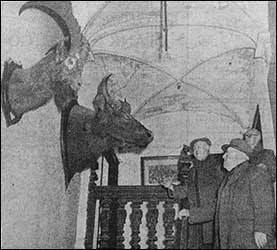|
||||
| The Rushden Echo and Argus, 14th January 1955, transcribed by Gill Hollis |
||||
|
Hall’s Future: How About This Idea?
|
||||
|
|
||||
In the midst of workaday Rushden, the park lies like a bit of old England, quiet and serene. Often the stillness is only broken by the song of birds in the stately trees and the babble of the stream. The Hall itself, home of Rushden’s Squires since it was built in the sixteenth century, is a fine mellow stone building, distinguished by the circular bay windows of the east front. The Sartoris family bought the Hall in 1849 and lived there until 1929, when it was put up for sale. Fear for Trees Older Rushden people say that the trees had been marked ready for felling when the Council stepped in and bought the land, the Hall going with it. A museum was the suggested use, but this idea had not come to fruition when, with the war, the Hall was used to billet Americans, who also had huts in the park. £10,000 Cure
Now the Council is again considering the use to which the Hall should be put. Basically, the idea is that the interior should be restored, and that the whole town should have the use of this fine old building. Novel Museum How? The Council has not yet got down to details. But if an outsider may make a suggestion, how about making at least part of it into a museum run on entirely novel lines? Rushden contains many bodies with distinctive histories and aspirations. What about offering each a room or part of a room to set up a permanent display of their own intended for posterity? For example, the Manufacturers’ Association could well set up a shoe trade exhibit that would at least equal that in Northampton Museum. Family Tableau It could include a complete tableau of one of the old shoemaking families who laid the foundations of Rushden’s prosperity, busy in their back garden shop. The Union, too, has its memories and its message, basis for a first-class display in which, perhaps, the head office at Earls Barton would take a leading part. The churches, the bands, the clubs, the pubs, transport, and the social services might all make their contribution to a museum that would call forth the co-operation and local pride of the whole town. |
||||
|
|
||||

